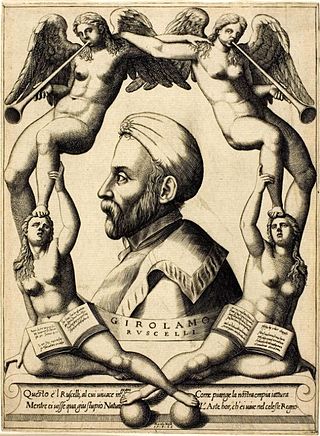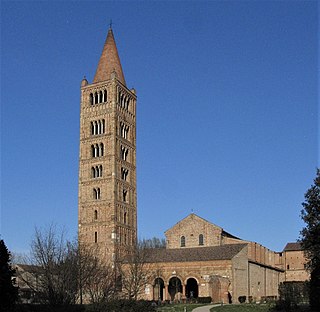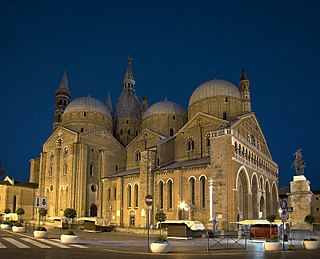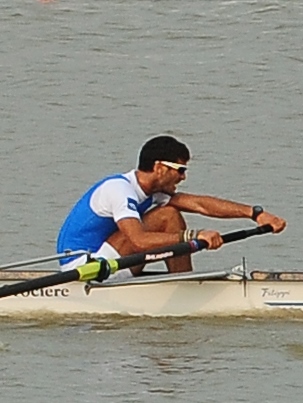
Girolamo Tiraboschi S.J. was an Italian literary critic, the first historian of Italian literature.

Marco Girolamo Vida or Marcus Hieronymus Vida was an Italian humanist, bishop and important poet in Christian Latin literature.
Antonio de Noli was a 15th-century Genoese nobleman and navigator, and the first governor of the earliest European overseas colony in Subsaharan Africa. He discovered some of the Cape Verde islands on behalf of Henry the Navigator and was made the first Governor of Cape Verde by King Afonso V. In most history or geographic books, including ancient chronicles, or encyclopedias, he is referred as Antonio de Noli. In Italy, he is known also as Antonio da Noli or sometimes as Antoniotto Usodimare.

Girolamo Ruscelli (1518–1566) was an Italian mathematician and cartographer active in Venice during the early 16th century. He was also an alchemist, writing pseudonymously as Alessio Piemontese.

Pomposa Abbey is a Benedictine monastery in the comune of Codigoro on the Adriatic coast near Ferrara, Italy. It was one of the most important in northern Italy, famous for the Carolingian manuscripts preserved in its rich library, one of the wealthiest of Carolingian repositories, and for the Romanesque buildings.

Dialogo de Cecco di Ronchitti da Bruzene in perpuosito de la stella Nuova is the title of an early 17th-century pseudonymous pamphlet ridiculing the views of an aspiring Aristotelian philosopher, Antonio Lorenzini da Montepulciano, on the nature and properties of Kepler's Supernova, which had appeared in October 1604. The pseudonymous Dialogue was written in the coarse language of a rustic Paduan dialect, and first published in about March, 1605, in Padua. A second edition was published later the same year in Verona. Antonio Favaro republished the contents of the pamphlet in its original language in 1881, with annotations and a commentary in Italian. He republished it again in Volume 2 of the National Edition of Galileo's works in 1891, along with a translation into standard Italian. An English translation was published by Stillman Drake in 1976.

Montesarchio is a comune in the Province of Benevento, Campania, Southern Italy. It is located 18 kilometres southwest of Benevento in the Valle Caudina at the foot of Monte Taburno. The commune was granted the official status of city (città) by a presidential decree of 31 July 1977. In 2020, it had a population of 13,226. It is one of I Borghi più belli d'Italia.
Jean Cuvelier (1882–1962) was a Belgian Redemptorist missionary and bishop of Matadi in Belgian Congo from 1930 until his death in 1962. Cuvelier was notable for his interest in the history of the Kingdom of Kongo, which he saw as a route to evangelization in his time. By stressing the Christian nature of the old kingdom, he hoped to increase the attachment of Kongo parishioners to the Catholic Church as opposed to Protestantism or traditional religions.

The Pontifical Basilica of Saint Anthony of Padua is a Catholic church and minor basilica in Padua, Veneto, Northern Italy, dedicated to St. Anthony of Padua.

Carlo Amoretti was an ecclesiastic, scholar, writer, and scientist. He entered the Augustinian order in 1757. To further his studies, he went to Pavia and Parma where he also taught ecclesiastical law.
Nsi Kwilu is a modern Kikongo respelling of "Essiquilu" the term used by the Italian Capuchin missionary Girolamo da Montesarchio in 1650 for the territory along the Kwilu River near Matadi in the modern-day Democratic Republic of Congo.
The decade of the 1470s in art involved some significant events.

The Lives of the Most Excellent Painters, Sculptors, and Architects, often simply known as The Lives, is a series of artist biographies written by 16th-century Italian painter and architect Giorgio Vasari, which is considered "perhaps the most famous, and even today the most-read work of the older literature of art", "some of the Italian Renaissance's most influential writing on art", and "the first important book on art history".

Girolamo Graziani was an Italian poet and diplomat.

Tomaso Porcacchi Castilione (1530–1576) was an author and cartographer.
Álvaro VII (Mpanzu-a-Mabondo) was king of the Kingdom of Congo from 1665 to 1666.
Giuseppe Leggiadri Gallani was an Italian poet and dramatist. He was a native of Parma in the era of the rule of the Farnese family.
Fra Serafino Razzi (1531-1613), born in Marradi and later residing in Florence, was a notable Italian Dominican friar celebrated for his contributions to music and literature.
Carlo Vecce is Professor of Italian Literature in the University of Naples "L'Orientale", he taught also in the University of Pavia, the D'Annunzio University of Chieti–Pescara and the University of Macerata. Abroad he was visiting professor at Paris 3 (2001) and University of California Los Angeles (UCLA) (2009).

Paolo di Girolamo is an Italian lightweight rower. He won a gold medal at the 2013 World Rowing Championships in Chungju with the lightweight men's eight.











